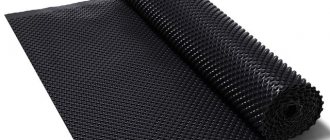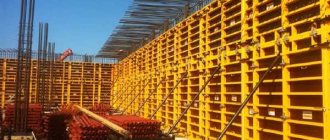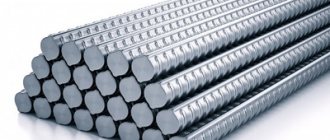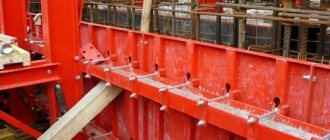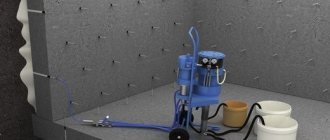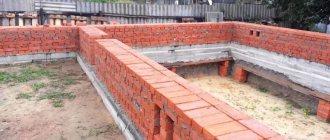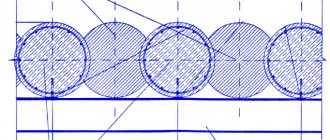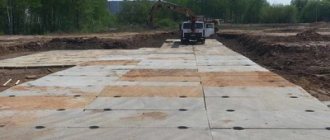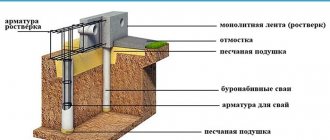Foundation waterproofing film is necessary to protect the building support from the destructive effects of ground moisture. It is laid after the foundation is poured. Previously, to provide such protection, concentrated cement mortar (proportion 1x1), as well as roofing felt, were used.
Today there is a wide variety of types of films. They are divided into two categories:
- Moisture insulation.
- Waterproofing.
The first category is selected if the building is built on a site with deep groundwater. Polyethylene film protects against moisture that appears in the soil as a result of rain or melting snow. This type of insulation is called light insulation. The second category is medium and heavy insulation. It is used if the groundwater level rises so much that it seeps through the foundation walls and enters the basement. Such waterproofing is mandatory in areas that suffer from seasonal floods. Regardless of the category of polyethylene protection, its use is necessary for the durability of any building.
Moreover, it is important not only to ensure that the basement is dry, but to ensure protection against moisture penetration into the concrete monolith after it is poured. Salts dissolved in groundwater have a detrimental effect on the building support, slowly destroying its structure.
Polyethylene film for foundation waterproofing
Polyethylene film for foundation construction ensures structural strength and stability under external influences. Waterproofing with such a film provides reliable resistance to moisture, but is extremely sensitive to sunlight and mechanical damage. Therefore, it is usually hidden underground. But here the second question arises - if the film is damaged, it will lose its water-repellent abilities. Therefore, the material is made from a special film that can withstand moderate loads. When pouring concrete, it often crumples and collapses, which requires special attention from a person when laying PVC film on the soil layer.
Polyethylene film
Foundation waterproofing film can provide high strength and reliability of the structure. If the work order is carried out correctly, the necessary strength can be guaranteed. Nowadays there are many types of waterproofing materials on the construction market.
Reinforced films
These materials are supplied in roll form, and the film itself is multilayer. The central part is made on the basis of a non-woven base or polypropylene mesh. The film is carefully sealed between the outer layer.
Nowadays we produce perforated waterproofing film for the foundation or non-perforated one. They differ in technical characteristics and quality. That's why their prices are different.
The first product has very small holes, which are responsible for the passage of a small amount of moisture. This film is most often used only for waterproofing work on pitched roofs.
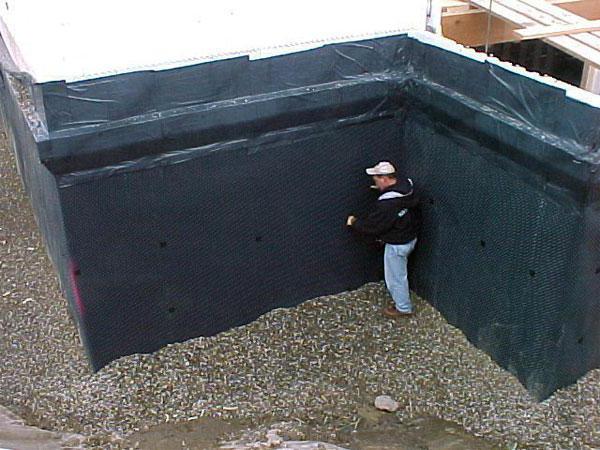
Non-perforated film does not allow moisture to pass through. The reinforcing layer allows you to protect the product from various deformations - this significantly increases its service life. Reinforced films intended for roofing and foundation waterproofing are also produced in the form of rolls and have different colors.
When choosing, you should take into account parameters such as surface density, but not thickness. So, the density should be from 100 to 200 grams per square meter.
Types and features of construction polymer films
Waterproofing the foundation with polyethylene film can guarantee the necessary technical and operational characteristics. At the same time, the choice of film for the foundation must be justified and selected for a specific case.
Arrangement of waterproofing, which is mandatory when constructing a foundation, is possible in various ways. At the same time, the use of film allows you to reduce costs and optimize the construction process. Among the types of film offered, the following stand out:
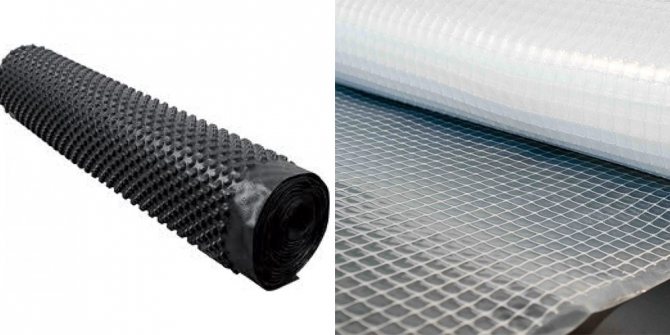
Types of construction films
- Standard flat films and PVC films
- Additional reinforced films
- Membrane film type
Traditional and long-used methods of waterproofing the base, among which roofing felt and mastic stand out, have their own characteristics and disadvantages. Waterproofing film serves as an excellent alternative to standard methods. It is characterized by ease of installation and high quality upon completion of construction. The presence of several layers leads to effective protection of the base.
The film is usually covered with additional layers of protective materials. Rubber and bitumen are used as materials. Waterproofing films are highly resistant to the negative and destructive effects of moisture and especially the salts and minerals present in its composition. It is especially beneficial to use additionally protected films in areas with difficult geotechnical conditions and a particularly aggressive environment in underground soils.
Polyethylene and construction
Here are the most popular ways to use polyethylene films in construction:
- Waterproofing the foundation from groundwater (use technical film with a thickness of 0.080-0.200 mm).
- Roof waterproofing (the film is laid as an additional layer under the main roof material).
- Protection of scaffolding and scaffolding (thanks to the polyethylene “cocoon” you can continue working on them even on rainy days).
- Sheltering construction equipment and building materials from moisture when storing them outdoors.
- Sun protection for materials sensitive to UV rays or high temperatures (black light-absorbing film is used).
- Packing of building materials (including fragile ones) during transportation.
- During interior finishing work, furniture and floors are covered with polyethylene to protect them from dust or paint, particles of which are formed during the finishing of walls and ceilings. Polyethylene film will reliably protect the furniture, and you will not have to completely vacate the room during the renovation.
Features of installing PVC film for foundation waterproofing
Waterproofing the foundation with film is a simple but effective measure. The film under the foundation guarantees excellent resistance to moisture entering the concrete and gradually penetrating into deeper layers.
Polyethylene film for the foundation is installed in several stages:
First of all, it is necessary to complete the preparatory stage, which is as follows:
- Leveling the underlying surface.
- Careful cleaning of reinforcement that protrudes from the concrete.
- Dust is blown off with a special compressor or vacuum cleaner.
- Applying primer.
- Applying a layer of waterproofing materials, which ends with pouring concrete mixture.
The foundation film is placed in the foundation pit only after the necessary work has been completed to level the soil and create a sand cushion. Depending on the technical characteristics of the soil at the construction site, individual planning for the creation of waterproofing layers and horizons takes place.
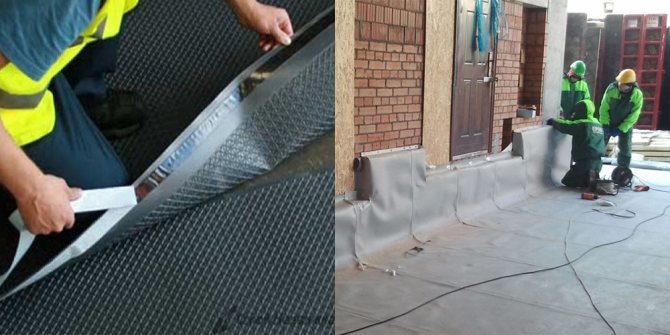
Installation of PVC film
After the pit has been dug and leveled, you can proceed to laying waterproofing polyethylene film. To prevent damage to the film structure, the formwork is fastened from the outside, and PVC film is spread inside the formwork. If the film is not covered with a continuous sheet, but in separate pieces, then an overlap of at least 20 centimeters should be created. All joining areas are impregnated with assembly glue to ensure that the sheets are held together as firmly as possible. When laying the film, you should ensure that it protrudes above the upper edge of the formwork by at least 10 centimeters.
The film plays an important role in the speed and quality of hardening of the concrete mixture. Concrete hardens faster and more evenly, which is important for achieving specified technical parameters. Thanks to the film, it is possible to limit the loss of moisture contained in the concrete - in other words, an optimal combination of moisture is created in the soil and concrete.
When backfilling, as when pouring a concrete mixture, it is necessary to carefully monitor the thorough leveling and uniform distribution of the layer of waterproofing film - this will prevent its destruction and even minor damage.
PVC film for foundation waterproofing guarantees the achievement of high quality insulation, and therefore the safety of the entire supporting structure.
What is a screed and why is it needed?
In simple words, a screed is the foundation of a floor. As a rule, it is made from a cement-sand mixture. In industrial premises, screed is the final floor covering. In an apartment, screed is used to make the floor level and add rigidity to it, as well as improve heat and waterproofing properties. There are four screed options, in each of which the polyethylene film will find its place:
- Wet screed. It is made with the addition of a large amount of water, and visually looks like solid concrete. To make the screed more durable, various strengthening solutions are used. Polyethylene film is used to create a waterproofing barrier.
- Semi-dry screed. The mixture consists of a large amount of sand and a small volume of water, from which this screed gets its name. This screed hardens much faster, but the strength is not as high. Plastic film will help speed up the drying process of the screed, as well as improve its strength. This type of screed is most often used in residential buildings and apartments.
- Dry screed. Its peculiarity is that its production does not require water at all, so you do not have to wait for the floor to dry. The floor is leveled using sheets of plywood. This option is universal and can also be used in residential areas.
- Self-leveling screed. Better known as self-leveling floor. The peculiarity is the presence of different grain sizes. This type of screed is sold in construction stores in the form of a dry mixture.
Weather conditions during installation
Once fully installed, it becomes independent of weather conditions. But during the installation itself, you need to adhere to some rules that are necessary to obtain a positive result.
Firstly, when working with PVC membranes, the temperature level in the environment must not be lower than minus 15°C.
Secondly, it is prohibited to install them in places where there is water, fog or other moisture.
Thirdly, if the conditions for repairs are not very favorable, then around the repair site you need to build an awning, a greenhouse or a hut in which all the necessary conditions for work can be provided.
Also read: Logicroof PVC membrane.
Advantages and disadvantages
Let's look at the pros and cons of waterproofing films for foundations. These materials are a worthy alternative to coating waterproofing compounds. Thus, films are widely used to protect vertical and horizontal foundation walls. But before installation, it is still recommended to conduct geological studies.
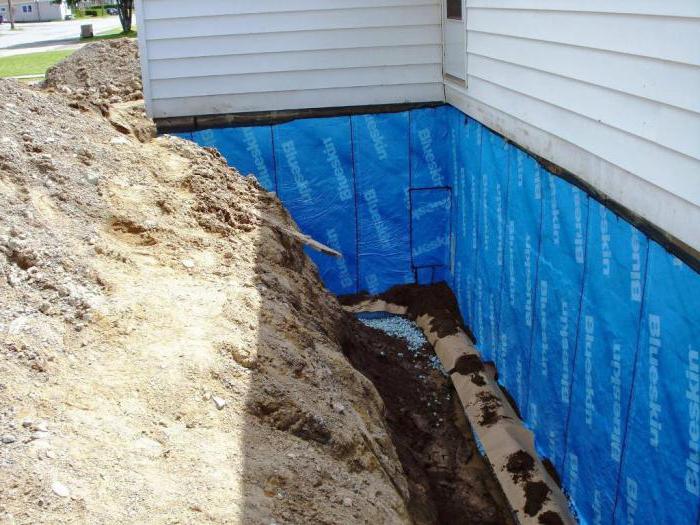
Among the disadvantages of films is a high risk of damage to the material due to low strength. Also, the surface must be well prepared before installation. Joint seams are problem areas. The film may be damaged due to exposure to aggressive components contained in water. The film may be damaged by rodents.
Membrane materials
This waterproofing is a product of the latest generation. The membranes are a self-adhesive film consisting of three layers. The first is ordinary polyethylene film. Next comes a bitumen-polymer layer, and then a special adhesive layer.
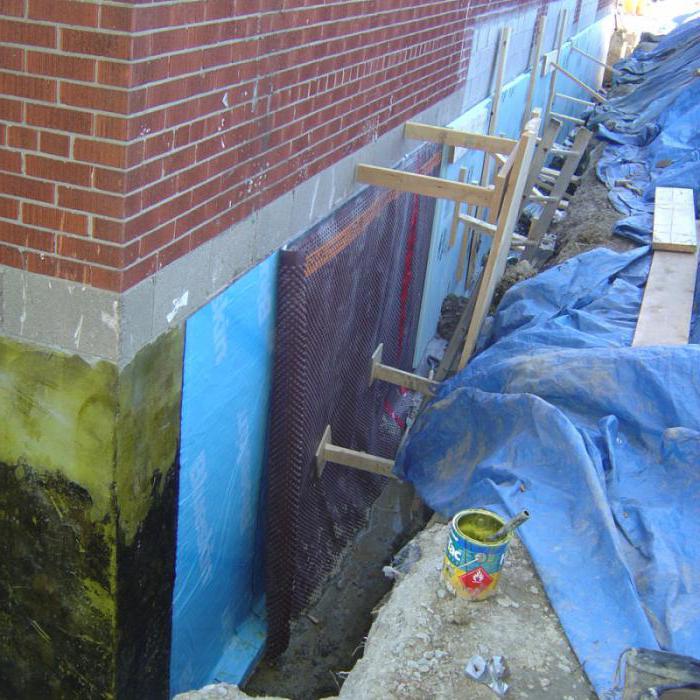
These solutions are not afraid of sudden temperature changes. They are easy to install and require no maintenance. To connect the membrane you need to use a hairdryer. By heating, a monolithic waterproofing is obtained.
Diffuser membranes
It is also a multi-layer material. Among the features is that the product allows hydroid steam to pass through, but remains completely waterproof. These types of waterproofing films for foundations are widely used for roofing work. The material has a distinctive feature - steam is removed from a special heat-insulating layer to the outside. Due to this feature, the product protects the foundation from moisture, various types of destruction and putrefactive processes. These products are used in very damp areas. These are saunas, baths, restaurants, cafes.
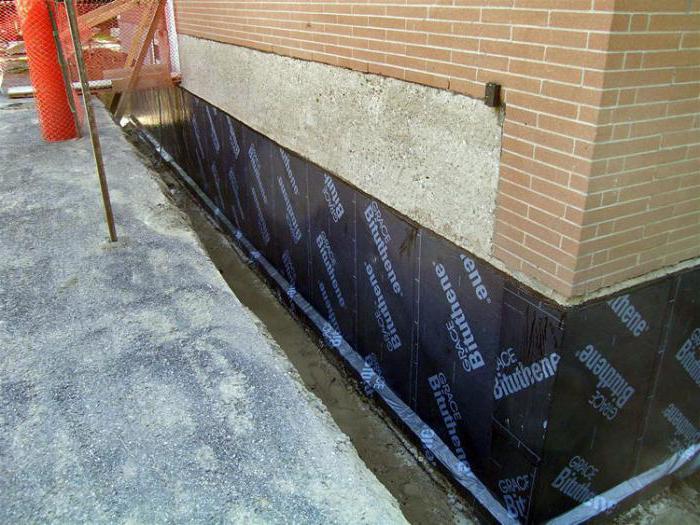
There is also a super-diffuser film on sale, which has high technical characteristics and protective capabilities. The price between a regular membrane and its “super” modification differs little. Therefore, for greater reliability and guarantee of maximum protection, experts recommend purchasing super-diffuser types.
